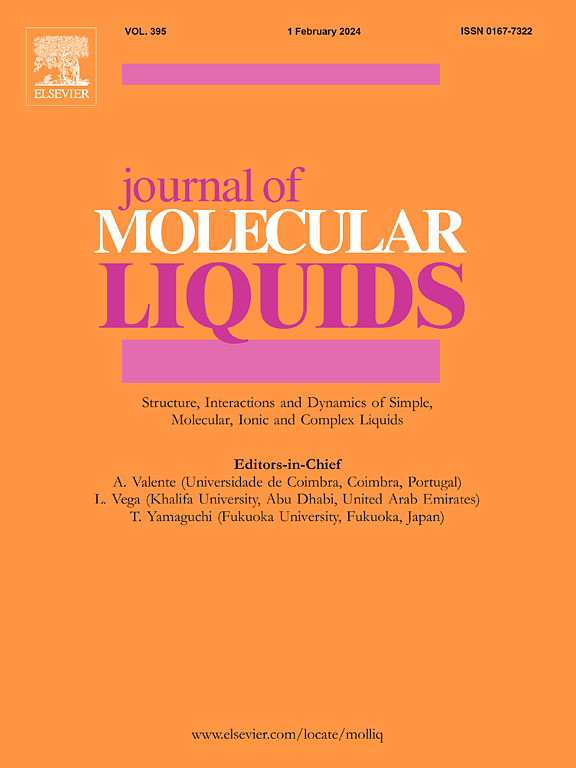优化了低温增产含天然气水合物沉积物的聚合物体系
IF 5.3
2区 化学
Q2 CHEMISTRY, PHYSICAL
引用次数: 0
摘要
含水合物沉积物(HBS)的低渗透率限制了天然气水合物储量的开采。虽然多井钻井和水平井等技术已经改善了储层的进入,但通过水力压裂提高储层的导流能力是很有希望的下一步。本研究评估了传统线性和交联凝胶与多糖和合成聚合物基天然气水合物抑制剂的低温刺激相容性。已建立的抑制剂如黄原胶(XG)、果胶和聚乙烯吡咯烷酮(PVP)在不同浓度的瓜尔胶(GG)和硼酸盐交联凝胶中进行了测试。XG集成线性凝胶的流变性能得到了显著改善,粘度增加了30%至90%,粘弹性增强了90%至200%,特别是在低温条件下。这些改进可归因于XG和GG之间的协同作用。与环境条件相比,纯果胶凝胶在低温下(5°C时高达407%)表现出了显著的(尽管不成比例的)粘度增加。然而,为了提高弹性和保证稳定性,GG的加入是必要的。将GG掺入果胶基质中,显著增强了凝胶的粘性和弹性特性。这项工作还强调了果胶在交联体系中的局限性,特别是在高pH条件下,在制备样品后几分钟内观察到快速溶胀和相分离。虽然pvp集成凝胶在线性和交联构型下都表现出稳定性,但在低于15℃的温度下,它们的流变性能会受到影响,从而导致结构完整性的丧失。这种特性使得它们更适合于水合物抑制应用,而不是提高压裂性能。这种新型的聚合物混合增产液优化技术提高了含天然气水合物沉积物(GHBS)作业的效率和稳定性,为实现能源安全和可持续、清洁的能源生产提供了一条有希望的途径。本文章由计算机程序翻译,如有差异,请以英文原文为准。
Optimized polymer systems for low-temperature stimulation of gas hydrate-bearing sediments
Production from gas hydrate reserves has been limited by the low permeability of hydrate-bearing sediments (HBS). While techniques like multi-well drilling and horizontal wells have improved reservoir access, enhancing reservoir conductivity through hydraulic fracturing is a promising next step. This study evaluates the compatibility of conventional linear and crosslinked gels with polysaccharides and synthetic polymer-based gas hydrate inhibitors for low-temperature stimulation. Established inhibitors like xanthan gum (XG), pectin, and polyvinylpyrrolidone (PVP) were tested in varying concentrations with guar gum (GG) and borate crosslinked gels. XG integrated linear gels exhibited significantly improved rheological performance, with viscosity increases ranging from 30 % to 90 % and viscoelastic enhancements between 90 % and 200 %, particularly under low-temperature conditions. These improvements can be attributed to synergy between XG and GG. Pure pectin gels exhibited a substantial, though disproportionate, increase in viscosity at low temperatures (up to 407 % at 5 °C) compared to ambient conditions. However, the addition of GG was necessary to improve elasticity and ensure stability. The incorporation of GG into the pectin matrix significantly enhanced both the viscous and elastic characteristics of the gel. The work also underscores the limitations of pectin in crosslinked systems, particularly under high pH conditions, where rapid deswelling and phase separation were observed within minutes after the preparation of sample. While PVP-integrated gels exhibit stability in both linear and crosslinked configurations, their rheological properties are compromised at temperatures below 15 °C, leading to a loss of structural integrity. This characteristic renders them more suitable for hydrate inhibition applications than for enhancing the fracturing performance. This novel optimization of polymer blends for stimulation fluids enhances the efficiency and stability of operations in gas hydrate-bearing sediments (GHBS), offering a promising pathway toward energy security and the sustainable, clean production of energy resources.
求助全文
通过发布文献求助,成功后即可免费获取论文全文。
去求助
来源期刊

Journal of Molecular Liquids
化学-物理:原子、分子和化学物理
CiteScore
10.30
自引率
16.70%
发文量
2597
审稿时长
78 days
期刊介绍:
The journal includes papers in the following areas:
– Simple organic liquids and mixtures
– Ionic liquids
– Surfactant solutions (including micelles and vesicles) and liquid interfaces
– Colloidal solutions and nanoparticles
– Thermotropic and lyotropic liquid crystals
– Ferrofluids
– Water, aqueous solutions and other hydrogen-bonded liquids
– Lubricants, polymer solutions and melts
– Molten metals and salts
– Phase transitions and critical phenomena in liquids and confined fluids
– Self assembly in complex liquids.– Biomolecules in solution
The emphasis is on the molecular (or microscopic) understanding of particular liquids or liquid systems, especially concerning structure, dynamics and intermolecular forces. The experimental techniques used may include:
– Conventional spectroscopy (mid-IR and far-IR, Raman, NMR, etc.)
– Non-linear optics and time resolved spectroscopy (psec, fsec, asec, ISRS, etc.)
– Light scattering (Rayleigh, Brillouin, PCS, etc.)
– Dielectric relaxation
– X-ray and neutron scattering and diffraction.
Experimental studies, computer simulations (MD or MC) and analytical theory will be considered for publication; papers just reporting experimental results that do not contribute to the understanding of the fundamentals of molecular and ionic liquids will not be accepted. Only papers of a non-routine nature and advancing the field will be considered for publication.
 求助内容:
求助内容: 应助结果提醒方式:
应助结果提醒方式:


